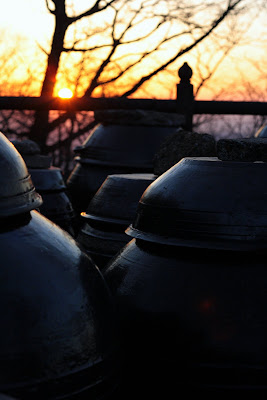I took pictures of everywhere we went - well most everywhere since I came down with a minor bout of gastroenteritis which turned into an acute gastroenteritis halfway through our trip, caused by either the slices of raw chicken or 9 month old margarine that I had eaten the week prior. Whatever it was, it put me out of whack and in a mood that wasn't very conducive to taking pictures.
Still, I persevered, and with the help of Korea's finest medicines, managed to drag myself and my camera out of our various hotels. These photos (more can be seen at http://picasaweb.google.com/melvillj) are the result of that trip.
We started our journey in Seoul shopping along crowded artisan streets, in jam-packed markets, and in the swank downtown area with all the famous brands. Somewhere in between, we managed to ride a cable car up to the top of Namsan, one of Seoul's many mountains and the only one with a 497 meter tower on the top where we were treated to a view of the full enormity of Seoul.
 |
| Like I said...Seoul is BIG |
After Seoul, we jumped back to Gwangju for one last day of teaching before the official vacation started. As soon as school let out, we were on our way to Busan, Korea's second largest city and home to it's most famous fish market.
In Busan, we eschewed the tower on the mountain in the middle of the city and instead wandered through the maze of alleys of the Kukje Market. We didn't buy much beyond the odd pair of socks and the lunch we ate sitting on tiny plastic stools in front of a gregarious ajumma serving us noodles in plastic bowls in the middle of one alley.
It was in Busan that my "mild" case of whatever it was I had turned "acute," and so we went to the hospital in search of aid and stronger antibiotics. When we arrived, a very helpful nurse who was obviously used to dealing with lost and stricken foreigners ushered me into her office and told me I'd have to wait for 45 minutes while the doctors finished their lunch.
I had mixed feelings about this. On the one hand, I really appreciate a country that places such a strong emphasis on lunch while at work. It shows that at least someone has their priorities in order. On the other hand, being told to wait 45 minutes with an acute case of whatever it was wasn't fun. I'm just glad I didn't ruin their meal.
An hour later, we departed the hospital with my stronger antibiotics and headed towards Beomeosa, Busan's largest and most famous temple. It's located about a half hour outside the city by train, and right as we got there the weather decided it would start to rain. Hard.
 |
| The Entrance to the Temple |
 | ||
| The temple in the Mountains. Note the sun |
 |
| The entrance to Paradise |
But last year, with some apocalyptic traffic and a ferry that didn't take cars, we were forced to skip the island altogether. Devon and I made it as far as Geojedo earlier this year, but didn't have enough time to cross the island and quite frankly had no clue how to get to Oedo, and so we left it unseen. This was the one place Devon wanted to visit before she left Korea.
Somehow we figured out how to get there, and boy oh boy were the promotional materials right. It was Paradise - beautiful blue sky, lush green vegetation, and statues of every kind everywhere. I was reminded of the real estate magazines I used to flip through as a kid, dreaming of owning a villa on the French Rivera or some Mediterranean Island somewhere...
 |
| Mediterranean Dreams |
 |
| Jinju by night |
Way back when, Jinju was the sight of a huge fortress and a couple of ferocious battles with the Japanese. The first ended in glorious victory for the Koreans, the second a couple of years later ended in crushing defeat and the deaths of some 70,000 Korean soldiers and civilians. After the battle though, Non-gae, a Korean "professional female entertainer," drowned herself in the river with one of the Japanese Generals.
 |
| Brave woman |
 |
| View of the fortress |
 |
| The right way to beat the heat |
 |
| My favorite picture from the whole trip |
Check out more pictures from the vacation here
















